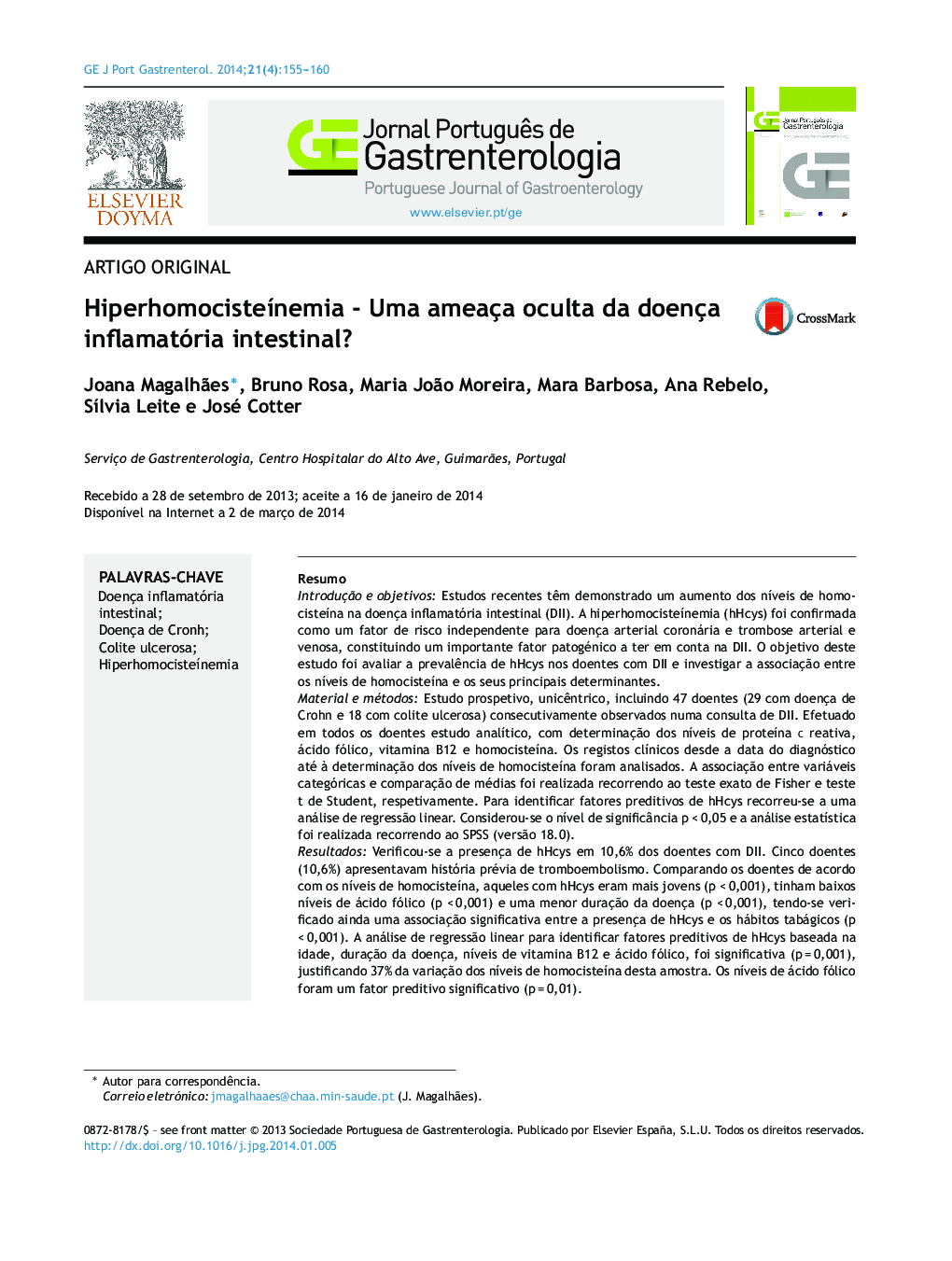| کد مقاله | کد نشریه | سال انتشار | مقاله انگلیسی | نسخه تمام متن |
|---|---|---|---|---|
| 3311029 | 1590264 | 2014 | 6 صفحه PDF | دانلود رایگان |

ResumoIntrodução e objetivosEstudos recentes têm demonstrado um aumento dos níveis de homocisteína na doença inflamatória intestinal (DII). A hiperhomocisteínemia (hHcys) foi confirmada como um fator de risco independente para doença arterial coronária e trombose arterial e venosa, constituindo um importante fator patogénico a ter em conta na DII. O objetivo deste estudo foi avaliar a prevalência de hHcys nos doentes com DII e investigar a associação entre os níveis de homocisteína e os seus principais determinantes.Material e métodosEstudo prospetivo, unicêntrico, incluindo 47 doentes (29 com doença de Crohn e 18 com colite ulcerosa) consecutivamente observados numa consulta de DII. Efetuado em todos os doentes estudo analítico, com determinação dos níveis de proteína C reativa, ácido fólico, vitamina B12 e homocisteína. Os registos clínicos desde a data do diagnóstico até à determinação dos níveis de homocisteína foram analisados. A associação entre variáveis categóricas e comparação de médias foi realizada recorrendo ao teste exato de Fisher e teste t de Student, respetivamente. Para identificar fatores preditivos de hHcys recorreu‐se a uma análise de regressão linear. Considerou‐se o nível de significância p < 0,05 e a análise estatística foi realizada recorrendo ao SPSS (versão 18.0).ResultadosVerificou‐se a presença de hHcys em 10,6% dos doentes com DII. Cinco doentes (10,6%) apresentavam história prévia de tromboembolismo. Comparando os doentes de acordo com os níveis de homocisteína, aqueles com hHcys eram mais jovens (p < 0,001), tinham baixos níveis de ácido fólico (p < 0,001) e uma menor duração da doença (p < 0,001), tendo‐se verificado ainda uma associação significativa entre a presença de hHcys e os hábitos tabágicos (p < 0,001). A análise de regressão linear para identificar fatores preditivos de hHcys baseada na idade, duração da doença, níveis de vitamina B12 e ácido fólico, foi significativa (p = 0,001), justificando 37% da variação dos níveis de homocisteína desta amostra. Os níveis de ácido fólico foram um fator preditivo significativo (p = 0,01).ConclusãoA hiperhomocisteínemia é um fenómeno frequente nos doentes com DII. Medidas preventivas devem focar‐se nos fatores de risco reversíveis relacionados com hHcys, tais como a cessação de hábitos tabágicos e a correção de défices vitamínicos.
Introduction and objectivesSeveral recent studies have reported increased homocysteine levels in Inflammatory Bowel Disease (IBD). Hyperhomocysteinemia (hHcys) has been proved to be an independent risk factor for coronary artery disease, arterial and venous thrombosis, making it an interesting candidate as a pathogenic link in IBD. The aims of this study were to assess the prevalence of hHcys in patients with IBD and to investigate the relation between homocysteine levels and its main determinants.Material and methodsSingle‐center prospective study including 47 patients (29 patients with Crohn's disease and 18 patients with Ulcerative Colitis) consecutively observed in a consultation of Inflammatory Bowel Disease. Blood samples were obtained from all patients following fasting and these samples were used for determination of C reactive protein, folic acid, vitamin B12 and homocysteine levels. Clinical data recorded from disease onset to the time of the homocysteine assay were analysed. Association between categorical variables and comparisons of means were tested by Fisher exact test and Student t test, respectively. To identify predictive factors of hHcys in patients with IBD, a linear regression analysis was applied. The statistical level of significance was established at 5%. Statistical analysis was performed with SPSS (version 18.0).ResultsIn our series, 10.6% of IBD patients were found to have hHcys. Five patients (10.6%) had a previous history of thromboembolism. Compared to patients with normal homocysteine levels, those with hHcys were younger (p < 0.001), had lower levels of folic acid (p < 0.001), and had a lower illness duration (p < 0.001). In patients with hHcys there also were a statistically significant difference according to smoking status (p < 0.001). Linear regression analysis to predict homocysteine levels based on age, illness duration, vitamin B12 and folic acid levels was significative (p = 0.001) and explain 37% of the variance found in homocysteine levels of this sample. The level of folic acid was a significant predictor (p = 0.01) of hHcys.ConclusionHyperhomocysteinemia is a common phenomenon in patients with IBD. Preventive measures could focus on reversible risk factors correlated with hHcys, such as cessation of smoking and correction of vitamin deficiencies.
Journal: GE Jornal Português de Gastrenterologia - Volume 21, Issue 4, July–August 2014, Pages 155–160